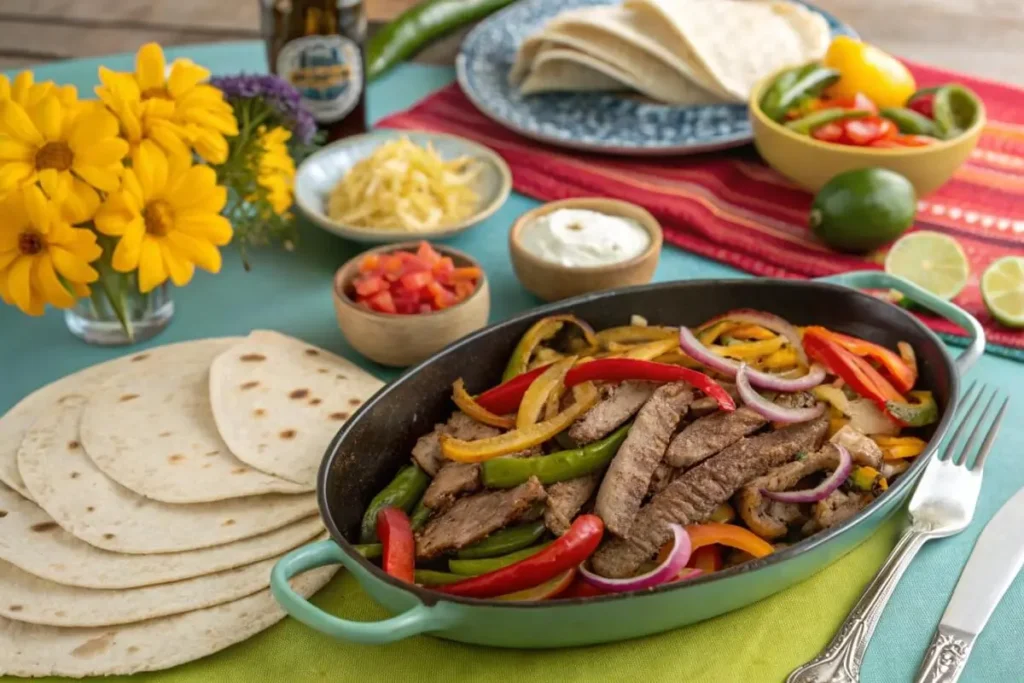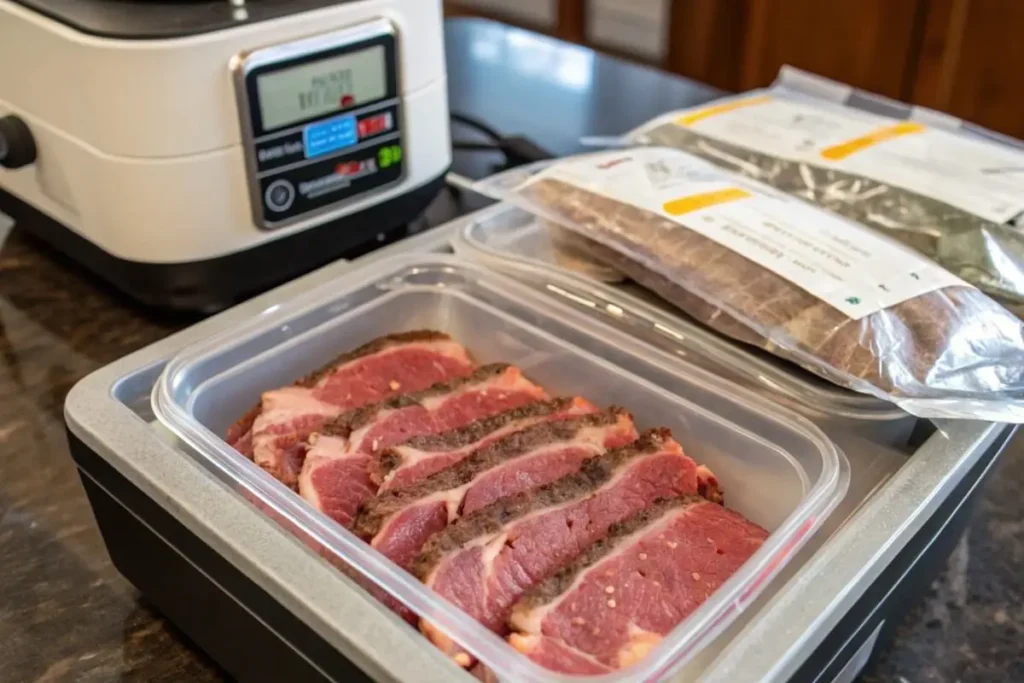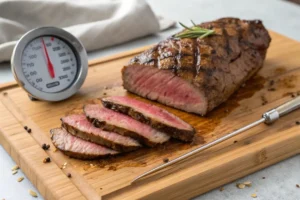When it comes to lean, flavorful cuts of beef, flank steak holds a special place in the hearts of meat lovers and health-conscious eaters alike. Its bold, beefy flavor combined with a low-fat content makes it an excellent choice for those who want to enjoy the taste of steak without compromising their dietary goals. Plus, flank steak’s versatility in the kitchen is unmatched—it’s a favorite for grilling, stir-frying, and even stuffing for gourmet meals.
But there’s more to flank steak than its taste and versatility. It’s a powerhouse of essential nutrients like protein, iron, and B vitamins, making it a smart addition to a balanced diet. Whether you’re new to cooking flank steak or looking to master its preparation, this guide will walk you through everything you need to know. From choosing the best cut to perfecting cooking techniques, you’ll soon see why this lean, tasty cut is a star in the culinary world.
So, are you ready to discover everything that makes flank steak so special? Let’s start by learning about what flank steak is and why it’s so beloved.
Table of Contents
What is This Popular Lean Cut of Beef?
Flank Steak’s Origins and Anatomy
Flank steak comes from the abdominal muscles of the cow, specifically the area located just below the loin and sirloin. This long, flat cut is known for its distinct grain, which runs parallel to the length of the meat. It’s sometimes called a “working cut” because it comes from a part of the animal that gets a lot of exercise. This means flank steak is lean and muscular, with very little fat marbling.
Historically, flank steak has been a favorite in many cuisines, particularly in Latin American and Asian cooking, where its rich flavor is celebrated. It’s often used in dishes like fajitas, carne asada, and stir-fries, thanks to its ability to absorb marinades and cook quickly.
Nutritional Benefits of a Lean Beef Cut
Flank steak isn’t just delicious—it’s also packed with nutrients. Here’s a breakdown of its nutritional highlights (per 3-ounce cooked serving):
- Calories: Around 160
- Protein: A whopping 23 grams
- Fat: Just 6 grams, with only 2 grams of saturated fat
- Iron: 10% of your daily recommended intake
- Vitamins: Rich in B vitamins, including B12, which supports energy and brain health
With its high protein content and low fat, flank steak is ideal for athletes, fitness enthusiasts, and anyone looking to build or maintain muscle while keeping their calorie intake in check.
Unique Characteristics of Flank Steak
What sets flank steak apart from other cuts of beef? For starters, its texture. Flank steak has a firm, chewy bite that’s incredibly satisfying when cooked and sliced properly. Its pronounced beefy flavor is another hallmark, making it a favorite for those who enjoy bold-tasting meat.
However, because of its low-fat content, flank steak can be a bit tricky to cook—it’s easy to overdo it, which can make the meat tough. But don’t worry! With the right preparation and cooking techniques (which we’ll cover soon), you can unlock the full potential of this flavorful cut.
Why Choose Flank Steak?
Flank Steak for Lean Meat Enthusiasts
Flank steak is the go-to choice for anyone who loves red meat but wants to avoid excessive fat. Compared to richer cuts like ribeye or T-bone steak, flank steak offers a leaner profile without sacrificing flavor. This makes it an excellent option for those managing their weight, cholesterol, or overall calorie intake.
For example, a typical serving of flank steak has significantly fewer calories and saturated fats than fattier cuts, yet still delivers a protein punch. This balance makes it an ideal choice for high-protein diets such as paleo, keto, or bodybuilding meal plans.
Health Benefits of Eating Flank Steak
- Protein Powerhouse:
With 23 grams of protein per 3-ounce serving, flank steak supports muscle growth, repair, and maintenance. It’s a smart choice for athletes or anyone with a physically active lifestyle. - Rich in Essential Nutrients:
Flank steak provides a wealth of essential nutrients, including:- Iron, which supports oxygen transport in the blood.
- Zinc, which boosts immunity and promotes wound healing.
- B12 and other B vitamins, vital for energy production and brain health.
- Low in Saturated Fats:
The lean nature of flank steak ensures it’s heart-health friendly when consumed in moderation. - Naturally Gluten-Free:
As a single-ingredient food, flank steak is a great choice for individuals with gluten intolerance or celiac disease.
Culinary Versatility of Flank Steak
Flank steak isn’t just nutritious; it’s a culinary chameleon that can adapt to countless recipes and cooking methods. Some reasons it’s a favorite among chefs and home cooks alike include:
- Absorbs Marinades Beautifully:
Its fibrous structure acts like a sponge, soaking up flavors from marinades. Whether you prefer a tangy citrus marinade or a savory soy-based one, flank steak enhances every bite. - Quick to Cook:
Thin and flat, flank steak cooks quickly on high heat, making it perfect for busy weeknights. - Pairs Well with a Variety of Flavors:
Its bold, beefy flavor is complemented by a range of seasonings and sauces, from chimichurri to teriyaki glaze. - Ideal for a Range of Dishes:
Use flank steak for hearty dishes like tacos, salads, wraps, or stir-fries. Its versatility means you’ll never run out of meal ideas.
How to Buy Flank Steak
Tips for Selecting the Best Cuts at the Market
Selecting the right flank steak at the butcher or grocery store can make all the difference in your cooking experience. Here’s what to look for:
- Freshness:
The steak should have a bright, cherry-red color with no grayish or brownish spots. - Texture:
Look for a cut that is firm to the touch and has a smooth surface. Avoid steaks with excessive sinew or connective tissue. - Marbling:
While flank steak is naturally lean, a slight amount of visible marbling (tiny streaks of fat) can enhance its flavor. - Thickness:
Choose a steak with even thickness to ensure uniform cooking.
Grass-Fed vs. Grain-Fed Beef
The diet of the cow significantly affects the taste and nutritional content of flank steak. Here’s how they differ:
- Grass-Fed Beef:
- Leaner and slightly tougher, with a robust, earthy flavor.
- Higher in omega-3 fatty acids and antioxidants.
- Often preferred for its environmental benefits and natural feeding process.
- Grain-Fed Beef:
- Tends to be more tender and has a milder flavor.
- Slightly higher in fat, which some find more indulgent.
Your choice will depend on your taste preferences and priorities, such as health or sustainability.
Preparing Flank Steak

How to Tenderize and Slice for Perfect Results
Flank steak’s lean, fibrous structure means it can be tough if not handled correctly. Fortunately, a few simple techniques can transform it into a tender, melt-in-your-mouth cut:
- Marination:
- Soak the steak in a marinade with acidic components like lemon juice, vinegar, or buttermilk. The acids help break down the proteins, making the meat tender.
- Popular ingredients for marinades include soy sauce, garlic, ginger, honey, olive oil, and Worcestershire sauce.
- Scoring:
- Lightly score the surface of the steak in a crosshatch pattern using a sharp knife. This helps marinades penetrate deeper into the meat and reduces shrinkage during cooking.
- Pounding:
- Use a meat mallet to pound the steak gently. This physically breaks down tough fibers and evens out the thickness for consistent cooking.
Flavor-Enhancing Marinades
The right marinade can elevate the taste of flank steak while adding a layer of tenderness. Here are some marinade ideas:
- Citrus Herb Marinade: Orange juice, lime juice, olive oil, garlic, and fresh cilantro.
- Asian-Inspired Marinade: Soy sauce, sesame oil, ginger, garlic, and a touch of honey.
- Classic Balsamic Marinade: Balsamic vinegar, Dijon mustard, olive oil, and thyme.
Let the steak marinate for at least 2 hours, or overnight for maximum flavor.
Proper Slicing Techniques
One of the most critical steps in preparing flank steak is slicing it correctly. Here’s how to do it:
- Against the Grain: Always slice against the grain—this shortens the muscle fibers and makes the steak easier to chew.
- Thin Slices: Keep the slices thin for the best texture and to fully enjoy the steak’s flavors.
Cooking Flank Steak
Mastering Cooking Methods for Lean Cuts
Flank steak’s thinness and lean nature make it ideal for high-heat cooking methods that lock in flavor quickly. Here are the best ways to cook it:
- Grilling:
- Preheat the grill to high heat.
- Cook the steak for 4-5 minutes per side for medium-rare.
- Let it rest for 5-10 minutes before slicing.
- Broiling:
- Set your oven to broil and place the steak on a broiler pan.
- Broil 3-4 inches from the heat source for 5-6 minutes per side.
- Pan-Searing:
- Use a heavy skillet, such as cast iron, and heat it until smoking hot.
- Sear the steak for 3-4 minutes per side, then finish with butter or aromatics like garlic and thyme.
- Sous Vide:
- Vacuum-seal the steak with seasonings and cook it in a water bath at 130°F for 2 hours.
- Finish by searing it on high heat to develop a crust.
Cooking Temperatures and Doneness Levels
Cooking flank steak to the right doneness ensures it retains its tenderness and flavor. Use a meat thermometer to check the internal temperature:
- Rare: 125°F
- Medium-Rare: 130-135°F
- Medium: 140-145°F
- Medium-Well: 150-155°F
- Well-Done: 160°F and above (not recommended for flank steak as it becomes tough).
Common Mistakes to Avoid When Cooking Flank Steak
- Overcooking: Flank steak becomes dry and chewy if cooked beyond medium. Aim for medium-rare to medium.
- Skipping Resting Time: Allow the steak to rest for 5-10 minutes after cooking to let the juices redistribute.
- Improper Slicing: Slicing with the grain can result in a chewy texture—always cut against the grain.
Flank Steak in Recipes
Quick and Easy Flank Steak Recipes
Flank steak is perfect for whipping up quick, flavorful meals. Here are some popular ideas:
- Beef Stir-Fry:
- Slice flank steak thinly against the grain and stir-fry with broccoli, bell peppers, garlic, and soy sauce.
- Serve over steamed rice or noodles for a quick dinner.
- Classic Fajitas:
- Marinate flank steak with lime juice, chili powder, cumin, and garlic.
- Grill or sear, then slice and serve with sautéed onions, bell peppers, and tortillas.
- Flank Steak Salad:
- Grill the steak to medium-rare, slice thinly, and serve over a bed of arugula with cherry tomatoes, avocado, and balsamic vinaigrette.
Flank Steak as a Centerpiece in Gourmet Meals
Flank steak can also be elevated for special occasions. Consider these ideas:
- Stuffed Flank Steak Rolls:
- Pound the steak thin, spread with a filling of spinach, mushrooms, and cheese, then roll it up and secure with twine.
- Sear and roast until cooked to perfection.
- Flank Steak Tartare:
- Dice raw flank steak finely and mix with capers, Dijon mustard, egg yolk, and seasonings.
- Serve with crostini for an elegant appetizer.
- Herb-Crusted Grilled Flank Steak:
- Rub the steak with fresh rosemary, thyme, garlic, and olive oil before grilling for a sophisticated twist.
Flank Steak in International Cuisines
Flank steak’s versatility makes it a favorite in dishes around the world:
- Mexican Carne Asada:
- Marinate the steak in lime juice, garlic, cilantro, and chili powder, then grill and serve with rice, beans, and tortillas.
- Korean Bulgogi:
- Slice thin and marinate in a mixture of soy sauce, sesame oil, garlic, ginger, and sugar.
- Cook quickly over high heat and serve with kimchi and rice.
- Mediterranean Steak Wraps:
- Grill flank steak with oregano and lemon juice, then wrap it in pita bread with tzatziki, cucumbers, and tomatoes.
Storing and Reheating Flank Steak
Proper Storage Techniques
To keep your flank steak fresh, follow these tips:
- Refrigeration:
- Store raw flank steak in an airtight container or vacuum-sealed bag. It will last up to 3-5 days in the refrigerator.
- Freezing:
- For longer storage, wrap the steak tightly in plastic wrap and aluminum foil, or use a vacuum sealer.
- It can be frozen for up to 6 months without losing quality.
- Leftovers:
- Store cooked flank steak in an airtight container in the refrigerator for up to 3 days.
Reheating Leftover Flank Steak Without Losing Flavor
- Low and Slow:
- Reheat steak in a 250°F oven until warmed through. Cover with foil to retain moisture.
- Steam Method:
- Place slices of steak in a steamer basket over simmering water for a few minutes.
- Avoid Microwaving:
- Microwaving can overcook the steak and make it rubbery. Stick to gentler methods.
Flank Steak vs. Other Cuts
How Does Flank Steak Compare to Other Beef Cuts?
Flank steak holds its own against other popular beef cuts, offering a unique balance of flavor, leanness, and versatility. Here’s how it stacks up:
- Flank Steak vs. Skirt Steak:
- Flavor: Both have bold, beefy flavors, but skirt steak is slightly fattier, giving it a richer taste.
- Texture: Flank steak is leaner with a firmer bite, while skirt steak is more tender and ideal for quick cooking.
- Cooking Uses: Flank steak is perfect for grilling and marinating, while skirt steak excels in fajitas and stir-fries.
- Flank Steak vs. Sirloin:
- Flavor: Sirloin has a milder taste compared to the robust flavor of flank steak.
- Nutrition: Flank steak is leaner, with less fat but slightly more calories due to its dense protein content.
- Cost: Flank steak is often more affordable, making it a cost-effective option for flavorful meals.
- Flank Steak vs. Ribeye:
- Flavor: Ribeye is marbled with fat, giving it a buttery, indulgent taste, while flank steak has a clean, lean flavor.
- Nutrition: Flank steak is a healthier option, with lower fat and calorie content.
- Cooking Style: Ribeye is best suited for slow cooking or pan-searing, while flank steak shines in quick, high-heat methods.
Cost-Effectiveness of Flank Steak
Flank steak is one of the most affordable cuts of beef, making it a popular choice for families and budget-conscious shoppers. Despite its lower price, it offers premium-quality flavor and texture when cooked properly.
Ethical and Sustainable Choices for Beef Lovers
Choosing Environmentally Friendly and Ethically Sourced Flank Steak
With increasing awareness of environmental and ethical concerns, more consumers are looking for sustainably sourced meat. Here’s how to make eco-conscious choices when buying flank steak:
- Support Grass-Fed Beef:
- Grass-fed cows are raised on natural pastures, reducing the environmental impact of grain farming.
- This method often aligns with ethical practices, ensuring animals are treated humanely.
- Look for Certified Labels:
- Opt for beef with certifications like “USDA Organic” or “Certified Humane.” These labels indicate higher standards of sustainability and animal welfare.
- Buy Local:
- Purchasing from local farms minimizes the carbon footprint associated with transportation. It also supports small-scale, sustainable farming operations.
- Waste Reduction:
- Flank steak’s versatility means you can use every part of the cut without waste, contributing to a more sustainable kitchen.
Flank Steak for Special Diets
Flank Steak in Low-Carb, Keto, and Paleo Diets
Flank steak is a dream ingredient for people following specialized diets:
- Low-Carb and Keto Diets:
- With virtually zero carbohydrates, flank steak fits seamlessly into keto and low-carb meal plans. Pair it with vegetables sautéed in healthy fats like olive oil for a balanced, diet-friendly meal.
- Paleo Diet:
- Since flank steak is minimally processed, it aligns perfectly with the paleo principle of eating whole, natural foods. Pair it with sweet potatoes or roasted root vegetables for a hearty paleo dish.
- Athlete-Friendly Diets:
- Its high protein content and low fat make it a staple for athletes and fitness enthusiasts looking to build or maintain muscle mass.
Flank Steak in Weight Management Plans
Flank steak’s lean profile and satisfying texture make it an excellent choice for weight management. Its high protein content helps control hunger, keeping you fuller for longer, while its low calorie count allows for indulgence without guilt.
Flank Steak FAQ

1. How Should I Store Raw Flank Steak?
Raw flank steak should be stored in the coldest part of your refrigerator, wrapped tightly in its original packaging or an airtight container. For longer storage, freeze the steak by wrapping it in plastic wrap and aluminum foil or using a vacuum-sealed bag.
2. How Can I Make Flank Steak More Tender?
Tenderize flank steak by marinating it with acidic ingredients like citrus juice or vinegar, scoring the surface, or pounding it with a meat mallet. Proper slicing against the grain after cooking is also key to enhancing tenderness.
3. What Are the Best Ways to Cook Flank Steak?
Flank steak is best cooked quickly over high heat using methods like grilling, broiling, or pan-searing. Sous vide is also a great option for evenly cooked, tender meat.
4. Can I Substitute Flank Steak with Other Cuts?
Yes, you can substitute flank steak with cuts like skirt steak, hanger steak, or flat iron steak. These cuts share similar textures and flavors, though cooking times may vary slightly.
5. How Do I Know When Flank Steak is Done?
Use a meat thermometer to check the internal temperature:
- Rare: 125°F
- Medium-Rare: 130-135°F
- Medium: 140-145°F
Let the steak rest for 5-10 minutes before slicing to allow the juices to redistribute.
6. What Dishes Are Best Suited for Flank Steak?
Flank steak is ideal for fajitas, stir-fries, salads, wraps, and gourmet dishes like stuffed steak rolls. Its bold flavor and lean texture pair well with a variety of seasonings and sauces.
Flank Steak: Lean, Tasty & Nutrient-Packed
Equipment
- Grill or Cast Iron Skillet
- Meat Thermometer
- Sharp Knife
Ingredients
Flank Steak
- 1 lb flank steak
Marinade
- 1/4 cup soy sauce
- 2 tbsp olive oil
- 2 tbsp lemon juice freshly squeezed
- 2 cloves garlic minced
- 1 tsp black pepper freshly ground
- 1 tsp Worcestershire sauce
Instructions
- In a bowl, combine soy sauce, olive oil, lemon juice, minced garlic, black pepper, and Worcestershire sauce to create the marinade.
- Place the flank steak in a resealable bag or shallow dish and pour the marinade over it. Cover and refrigerate for at least 2 hours or overnight for best results.
- Preheat a grill or cast iron skillet to high heat.
- Remove the steak from the marinade and pat dry. Grill for 4-5 minutes per side for medium-rare, or until the internal temperature reaches 130-135°F (54-57°C).
- Let the steak rest for 5-10 minutes before slicing.
- Slice thinly against the grain and serve immediately.
Notes
Conclusion
Flank steak is truly a cut above the rest when it comes to lean, flavorful, and versatile options for beef lovers. Its rich, beefy taste and nutrient-packed profile make it a perfect choice for health-conscious eaters, athletes, and food enthusiasts alike. Whether you’re grilling it for a summer barbecue, using it in a quick stir-fry, or elevating it for a gourmet dinner, flank steak delivers every time.
By choosing high-quality, sustainably sourced flank steak and mastering preparation and cooking techniques, you can enjoy this delicious cut at its best. So, the next time you’re planning your meals, don’t overlook this lean, tasty, and nutrient-rich steak—it just might become your favorite go-to protein.
Related Recipes and Resources
To elevate your cooking skills and explore similar culinary ideas, check out these related articles:
- Discover the secrets to cooking ranch steak perfectly every time, which shares insights into achieving tenderness in tougher cuts of beef.
- Learn about the ultimate guide to spinalis steak for tips on preparing premium cuts.
- For quick and flavorful meals, try this fast beef brisket recipe for a delicious alternative to flank steak.
- Tropical Pineapple Salsa -Fresh, Flavorful, and Easy to Make
- Homemade Salsa for Canning – Honeybunch Hunts
- Easy Homemade Salsa Verde | Complete Guide
- Black Bean Corn Salsa – Fresh and Flavorful Recipe
- Pineapple Salsa That Wows at Every Party

